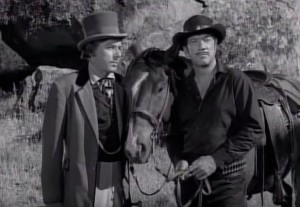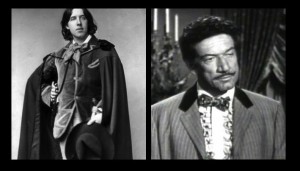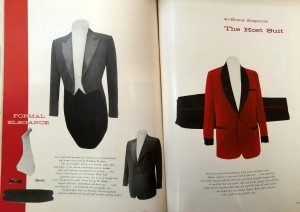How the West Was Wilde
Today is Oscar Wilde’s birthday, and my American tribute marks the occasion by revisiting the high style Wilde brought to the frontiers of the television Western and men’s fashion magazines in the 1950s. (I teach a course on the American 1950s.) Wilde’s 1882 lecture tour of the United States made him an indelible figure in the national imagination, reappearing when and where we least expect him. This Wilde Effect highlights a wider range of American masculinities than the era’s suburban Breadwinner and Organization Man.
The Ballad of Oscar Wilde
What’s a Dandy like Oscar Wilde doing in an American TV Western in 1958? “The Ballad of Oscar Wilde” was the 12th episode of Have Gun – Will Travel (season 2), starring Richard Boone as the gentlemanly hired gun, Paladin. With the official closing of the American frontier in 1890, Westerns had room to roam across the Atlantic as well as the 19th century. A highly literate chess master who resides in San Francisco’s Hotel Carlton, Paladin dons fancy suits for civilized pursuits and the requisite black attire when he is working. This episode opens with a poster for Wilde’s lecture “The American Barbarian,” which Paladin notices is Sold Out. I won’t spoil the plot, but I’ll say that it involves Oscar Wilde, some crooks, a ransom, the Civic Cultural Society in San Diego, and Paladin’s recitations of Wilde witticisms (you can watch the episode here). In fact, Paladin pre-cites an aphorism the Victorian dandy hasn’t written yet: “The only way to get rid of a temptation is to yield to it.”
Wilde Strains and Uncommon Sense
Two years earlier, Gentry (an upscale men’s style magazine) published its 20th issue. A mash-up of literature and luxury, museums and manors, shopping and fashion, “America’s fabulous magazine for men” offered its gentleman readers essential elements of refined living. This particular issue ushers in the Wilde West through two pieces appearing in proximity: an excerpt from Paul Horgan’s Pulitzer prize-winning epic Great River: The Rio Grande in American History (1955), and a cleverly-designed series of excerpts from Wilde himself. The editors promise readers that Horgan’s excerpt (“A Wild Strain”) will be “wilder than Hollywood’s wildest western.” In “An Alphabet of Uncommon Sense,” the editors offer 26 witty Wilde quotations, including delicious digs at American culture and sensibility. Like Paladin, the editors relish Wilde’s language of paradox: “The Soul is born old, but it grows young; that is the comedy of life. The Body is born young and grows old; that is Life’s tragedy.” There is a Wilde Strain in the issue’s feature on Thomas Eakins and his images of young men. Indeed, there is a Wilde Strain in the fashion portfolios that graced each issue, including these sumptuous suitings from the Age of Elegance issue (Fall 1955):
The fashion editor highlights the Host coat’s red velvet fabric with black bengaline lapels and cuffs, luxuriously complementing the black bengaline trousers with red velvet striping. Surely Oscar Wilde would have coveted such splendid attire for hosting his dinner parties.
The Wilde Effect made the American 1950s more fabulous. It brought sartorial splendor to popular culture, eschewing the Western hero’s chaps and denims, embellishing Organization Man’s gray flannels suits. So why not take a walk on the Wilde side to celebrate his 161st birthday? Remember to dress as you will, and to wear it well. –MB



Comments are currently closed.